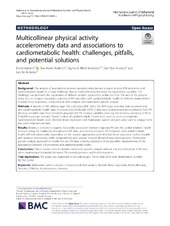| dc.contributor.author | Aadland, Eivind | |
| dc.contributor.author | Kvalheim, Olav Martin | |
| dc.contributor.author | Anderssen, Sigmund Alfred | |
| dc.contributor.author | Resaland, Geir Kåre | |
| dc.contributor.author | Andersen, Lars Bo | |
| dc.date.accessioned | 2020-06-17T11:30:38Z | |
| dc.date.available | 2020-06-17T11:30:38Z | |
| dc.date.issued | 2019-08-27 | |
| dc.Published | Aadland E, Kvalheim OM, Anderssen SA, Resaland GK, Andersen LB. Multicollinear physical activity accelerometry data and associations to cardiometabolic health: Challenges, pitfalls, and potential solutions. International Journal of Behavioral Nutrition and Physical Activity. 2019;16:74 | eng |
| dc.identifier.issn | 1479-5868 | en_US |
| dc.identifier.uri | https://hdl.handle.net/1956/22679 | |
| dc.description.abstract | Background: The analysis of associations between accelerometer-derived physical activity (PA) intensities and cardiometabolic health is a major challenge due to multicollinearity between the explanatory variables. This challenge has facilitated the application of different analytic approaches within the field. The aim of the present study was to compare association patterns of PA intensities with cardiometabolic health in children obtained from multiple linear regression, compositional data analysis, and multivariate pattern analysis. Methods: A sample of 841 children (age 10.2 ± 0.3 years; BMI 18.0 ± 3.0; 50% boys) provided valid accelerometry and cardiometabolic health data. Accelerometry (ActiGraph GT3X+) data were characterized into traditional (four PA intensity variables) and more detailed categories (23 PA intensity variables covering the intensity spectrum; 0–99 to ≥10,000 counts per minute). Several indices of cardiometabolic health were used to create a composite cardiometabolic health score. Multiple linear regression and multivariate pattern analyses were used to analyze both raw and compositional data. Results: Besides a consistent negative (favorable) association between vigorous PA and the cardiometabolic health measure using the traditional description of PA data, associations between PA intensities and cardiometabolic health differed substantially depending on the analytic approaches used. Multiple linear regression lead to instable and spurious associations, while compositional data analysis showed distorted association patterns. Multivariate pattern analysis appeared to handle the raw PA data correctly, leading to more plausible interpretations of the associations between PA intensities and cardiometabolic health. Conclusions: Future studies should consider multivariate pattern analysis without any transformation of PA data when examining relationships between PA intensity patterns and health outcomes. | en_US |
| dc.language.iso | eng | eng |
| dc.publisher | BMC | en_US |
| dc.rights | Attribution CC BY | eng |
| dc.rights.uri | http://creativecommons.org/licenses/by/4.0/ | eng |
| dc.title | Multicollinear physical activity accelerometry data and associations to cardiometabolic health: Challenges, pitfalls, and potential solutions | en_US |
| dc.type | Peer reviewed | |
| dc.type | Journal article | |
| dc.date.updated | 2019-10-29T07:40:15Z | |
| dc.description.version | publishedVersion | en_US |
| dc.rights.holder | Copyright 2019 The Author(s) | en_US |
| dc.identifier.doi | https://doi.org/10.1186/s12966-019-0836-z | |
| dc.identifier.cristin | 1727484 | |
| dc.source.journal | International Journal of Behavioral Nutrition and Physical Activity | |

